Food for thought
The “Brief” calls out key insights to inspire great ideas
In this course, the Creative Strategy Statement acts as the “Brief”
Perception is Reality
Mindset matters more than statistics
Real consumers deserve real talk
Cultural trends influence advertising and vice versa
Every ad agency has its own version of “The Brief” – a document that outlines the strategy the creatives must use as inspiration when coming up with ideas and campaigns. Some briefs are multiple pages. Some are three sentences. In my Copywriting course, students develop two documents that together, create their strategic “playground”. These are the Creative Strategy Statement and the Campaign Proposal. I call these “The Twin Wonders”. I’ve adapted these two documents that were originally created by Professor Nancy R. Tag, to help Advertising and PR undergrads at the City College of New York learn how to craft strategies that are as strong as the campaigns they inspire.*
Let’s start with Twin #1: the Creative Strategy Statement. Here’s a screenshot of the most recent Creative Strategy Statement (CSS) template that I use in my class.

As discussed earlier, the strategy helps the copywriter discover what the product/service offers that matters to real people (in plain english). A sound strategy must investigate the product/service, the consumer, and the marketplace.
Creative Strategy Statement
- Product Description <<
- Consumer
- Message
- Marketplace
When drafting a Creative Strategy Statement, start with the Product Description.
Every product/service has multiple features or facts. A key feature of Google Maps is that it can provide real-time info to help you decide which subway line or highway to take. Why does that matter to you, the consumer? What’s the benefit? If you’re on your way to take a final exam, your grade could depend on having accurate directions. If you’re on your way to your wedding, choosing the wrong route could result in your intended feeling left at the altar.
In order to discover the real benefit of Poo-Pourri to consumers, it’s helpful to use the FaBs method (Feature and Benefit) to identify the “What’s In It For Me” (WIIFM) for the consumer.
For example, a short list of Poo-Pourri facts/features might include:
- Travel size
- Multiple scents
- Natural ingredients
How do you determine which of these facts or features the consumer cares about? Keep delving deeper and deeper into the Benefit, the Benefit of the Benefit, the Benefit of the Benefit of the Benefit. That’s exactly what you’ll be doing for Poo-Pourri. But first, an example of how FaBs work.
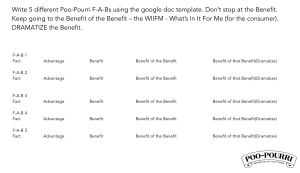
FaB Example 1
Herman Miller Aeron Chair
You might have never seen or sat in a Herman Miller Aeron chair. It’s an iconic, mid-century office chair that’s still popular today. It’s adjustable, supportive, comes in multiple sizes and colors. It has a self-correcting tilt feature. And it’s expensive. In this description, I listed multiple facts/features.
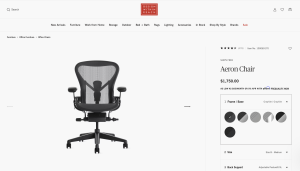
Which of the facts/features would make an Aeron chair something a consumer couldn’t live without? It depends on the consumer. Below is the FaB template that compares three of the facts/features side by side to see which might be the most compelling to the consumer.
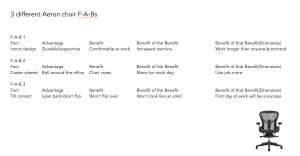
So who is the consumer? Let’s say that our consumer is a recent college grad. It’s their first day at their dream job. Their cubicle has an Aeron chair and a killer view. But they have to lean way back to see it. In this case, I’d say the Fact/Feature that matters most to them is:
Fact/Feature: This chair tilts back but self-corrects.
Benefit: It won’t flip over.
Benefit of Benefit: They can catch the view without looking like an idiot on their first day of work.
Benefit of Benefit of Benefit: They won’t get fired on their first day.
Does this example seem overly DRAMATIC? Maybe. But keep this in mind: if you’re interrupting someone’s day with a piece of advertising, don’t they deserve a little entertainment?
FaB Example 2
Just For Men
Just For Men, the #1 men’s hair and beard color brand, has a shampoo-in product that eliminates grey hair in 5 minutes and it lasts up to eight weeks. The sentence you just read contains 4 different facts/features.
- Just For Men is a shampoo-in product
- Just For Men eliminates grey hair
- Just For Men eliminates grey hair in 5 minutes
- Just For Men lasts up to eight weeks
Which is the fact or feature that matters the most? Let’s use the FaBs method to find out. We’ll try to discover the ultimate benefit of each.
Feature / Benefit / Benefit of the Benefit / Benefit of Benefit of Benefit
Shampoo-in / Easy to use/Don’t have to go to a salon/ No one will know you use it
Gets rid of greys / Makes you look younger / Avoid ageism at work / Longer career
5 minutes / Time saver / Spend more time w/your kids / Kids will avoid psychotherapy
8 weeks / Sexier longer / Get more dates in less time / Find “the one” quickly
Side note
How do we know that these benefits are real? If you were working for the JFM’s ad agency as a strategist, you would have access to research, or would conduct the research to support these findings. In fact, these FaBs were identified by a variety of students in my Copywriting classes who did their own research.
When you use the FaB method, you should also do the same – do your research to discover what the ultimate benefit, the What’s In It For Me, might be.
When using the FaBs method, I encourage my students to come up with multiple FaBs and then try to build off of the FaB that has the most potential – the WIIFM their consumer will relate to, will connect to emotionally, in the most dramatic way. Which of these FaBs is the best of this bunch? The fourth FaB that focuses on the fact that JFM lasts for up to 8 weeks, which could help the consumer stay sexier longer, get more dates and find “the one” in record time.
1) PRODUCT DESCRIPTION
Feature Benefit End Benefit/WIIFM
Lasts up to 8 weeks Stay sexy longer Find “the one” quickly
Let’s keep going. The next Product section of the Creative Strategy Statement is Perception and Reality.
It’s common for consumers to think a product can’t do what they want it to do. So they buy another product instead. This is called (mis) Perception. A major goal of advertising is to help consumers understand that a product can in fact do what they want it to do – and maybe more. It’s about changing their (mis) Perception by helping them understand a new Reality.
In the case of Just For Men, many men think it doesn’t last long. In fact, it lasts up to 8 weeks. Most of my students are way too young to worry about grey hair. But take it from me – I started getting grey hair when I was 28 – and I quickly learned that most hair dyes only last 3-4 weeks, at most. A hair dye that covers greys for up to 8 weeks is practically a miracle product.
So the JFM (mis) Perception is: the color doesn’t last.
The new Reality that we want men to know is: the color lasts up to 8 weeks.
1) PRODUCT DESCRIPTION
Feature Benefit End Benefit/WIIFM
Lasts up to 8 weeks Stay sexy longer Find “the one” quickly
(mis) Perception: Color doesn’t last long.
Reality: Color lasts 8 weeks.
Perception Reality Example
Perception is Reality – how a magazine for rock and rollers became the most famous music magazine in the world.
The way you perceive a brand’s product or service is reality – your reality. In an era of disinformation and information overload, brands work hard to make sure you perceive their products and services in a positive light. They want you to understand what the product can really do for you. How it can help you – in a way that matters to you.
A classic example of shifting a misperception to a new reality is Rolling Stone magazine. In its early years, the magazine was known for its hippie optimism. But over time, it shifted to become a magazine that featured a glamorous pop-star lifestyle, with readers to match. (You can read about this shift of focus in The Atlantic.)
Unfortunately for Rolling Stone, while its editorial focus (and readership) shifted, most high-end brands didn’t want to advertise in the magazine because their perception remained that Rolling Stone’s readers were a bunch of stoned hippies with no money to buy their luxury products. As ads declined, the magazine’s revenue dwindled. Fallon McElligott Rice, an ad agency based in Minneapolis was tasked with changing the perception of the magazine’s readers; that they were no longer hippies but were actually affluent and mainstream.
The ads pointed to the buying power of the magazine’s audience— through simple, powerful visuals and compelling body copy. A few of the ads are below. Watch this video to see more. (https://docs.google.com/presentation/d/1aabEvTm8Z0MCE5lKbvYisTYOV7RrL4zX5bWcHB1oNnY/edit#slide=id.g1891d28239d_0_559)

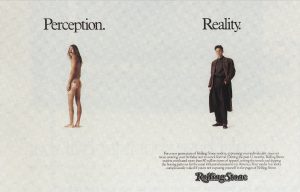
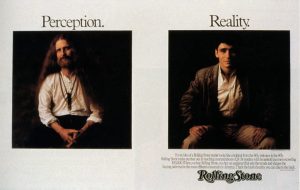
Sample Perception/Reality ad body copy:
TO THOSE OF YOU WHO ARE STILL SHORTCHANGING THE BUYING POWER OF A ROLLING STONE READER, DEPOSIT THIS IN YOUR INFORMATION BANK: OVER TWO AND A HALF MILLION ROLLING STONE READERS ARE CARD-CARRYING CAPITALISTS, LAST YEAR SPENDING MORE THAN THIRTEEN BILLION DOLLARS IN DEPARTMENT STORE AND OTHER RETAIL OUTLETS. CASH IN ON THE ACTION IN ROLLING STONE.
Note: Rolling Stone magazine has 400,000+ subscribers today.
If you’re interested in American music, politics and pop culture, this 4-part documentary by Real Stories on YouTube about Rolling Stone might be your jam. Founded in 1967 in San Francisco by Jann Wenner, Rolling Stone, the world’s most famous music magazine, became a cultural beacon that helped shape America and defined generations, always understanding that rock ‘n’ roll was more than simply music. The doc features performances by an eclectic mix of artists, including The Rolling Stones, Bruce Springsteen, Tina Turner, Janis Joplin and The Clash, and spotlights the magazine’s impact by showcasing many groundbreaking stories of its writers. There are also previously unheard audio recordings, interviews, and rare photos and footage.
Creative Strategy Statement
- Product Description
- Consumer <<
- Message
- Marketplace
Let’s move on. In order to know What’s In It For your consumer, you need to know who you’re talking to – who is your consumer?
For JFM, when deciding which FaB had the most potential, the student had a certain consumer in mind: a man who had at least some grey hair, who was tired of being single, who longed to meet the right woman. Notice that the focus wasn’t on the consumer’s demographics: his age, his ethnicity, his income, or education. The focus was on his mindset.
I’m not saying that demographics aren’t worth considering. But this isn’t a Market Research class. i=It’s a Copywriting class where I want you to think like a Creative, not like a Researcher. In my class, I ask my students to focus on what makes their Consumer tick, rather than reducing their Consumer to a statistic.
Not convinced? What if the product you’re being asked to create a campaign for is Billie, a razor designed for women that you buy online through a subscription service. The Demographics of your Consumer are as follows: a 40-year-old woman who is highly educated, lives in an urban area, with an income of $100,000+ per year.
Here are some of the women who fit your demographic profile. Would it make sense to market to them in the same way? Their ethnicity and values vary. Wouldn’t you want to know more about each of these consumers – what they care about, what motivates them? That’s why Psychographics are important – especially for this course.
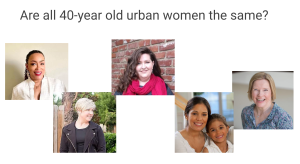
Let’s get back to our JFM consumer: a man who wants to cover his grey hair so that he can get more dates because he’s tired of being single; he wants to meet his soulmate. Here’s what that would look like in the Creative Strategy Statement (CSS).
1) PRODUCT DESCRIPTION
Feature Benefit/WIIFM
Lasts up to 8 weeks Stay sexy longer; find Ms. Right
(mis) Perception: Color doesn’t last long.
Reality: Color lasts 8 weeks.
2) WHO ARE WE TALKING TO (CONSUMER)?
Psychographically (mindset):
A man who is tired of being single; who is ready to meet “the one”.
Demographically:
30s, 40s, 50s man with greying hair
Creative Strategy Statement
- Product Description
- Consumer
- Message <<
- Marketplace
Next, we need to figure out what message our Consumer needs to hear that will make him understand that JFM isn’t just another hair dye – that it’s something that could change his life. After a few weeks of writing and rewriting and more rewriting, here’s what the student came up with:
JFM lasts eight weeks – plenty of time to find Ms. Right.
Note: This is what the student wants the consumer to take away when he sees the campaign – it’s what he wants the consumer to think. Note that it contains zero marketing speak. It’s not full of jargon. It’s not vague. It has an emotional hook. Here’s how NOT to state the message:
JFM lasts a considerable time and gives you the opportunity to meet your significant other.
Many students are surprised that I make them rewrite their strategy. “It’s not copywriting”, they say. “It’s the message, not the headline”. And they’re right. The Main message is the what to say. Copywriting is HOW to say it. But it’s important to get in the habit of writing EVERYTHING in plain english, in what I call “real talk” – the way you’d say it to a real person. No one wants to be thought of as a “target”. So why speak to them in marketing speak?
Try to imagine your consumer is a real person. Someone you know. A friend. A family member. A co-worker. Help them understand how a certain product or service can help them – in a way that matters to them. Tell them in plain english so they understand what’s in it for them.
1) PRODUCT DESCRIPTION
Feature Benefit/WIIFM
Lasts up to 8 weeks Stay sexy longer; find Ms. Right
(Mis) Perception: Color doesn’t last long.
Reality: Color lasts 8 weeks.
2) WHO ARE WE TALKING TO (CONSUMER)?
Psychographically (mindset):
A man who is tired of being single; who is ready to meet “the one”.
Demographically:
30s, 40s, 50s man with greying hair
3) MAIN MESSAGE
JFM lasts eight weeks – plenty of time to find Ms. Right.
Creative Strategy Statement
- Product Description
- Consumer
- Message
- Marketplace <<
We’re ¾ of the way through the Creative Strategy Statement. Time to finish it up by writing The Marketplace. Notice that this has two parts: What’s going on culturally – the Trend; and who is the Competition. Together these two factors help us understand the CONTEXT in which our advertising will exist. Why is this important?
4) MARKETPLACE
What’s going on culturally – the Trends:
The Competition (direct and indirect):
Trends matter because advertising mirrors and reflects the world we live in. It influences society and culture; and society and culture influence Advertising. Successful advertising is relevant to what’s going on now. It’s not tone deaf or offensive. It helps people feel seen and heard. At the same time, it has the power to spread ideas and help trends grow.
Here are some current trends – no doubt you can think of more:
- quiet quitting
- self care
- the metaverse
- consumerism vs climate
- diversifying identity
- love languages
- creator culture
- body positivity
- return to city living
- return to renting
In the case of Just For Men, an important Trend the student took into consideration is the fact that self-care is something we all think about these days. So being concerned with your looks and image; spending time and money on grooming is manly – and even sexy.
Another current Trend is that while it’s perfectly fine to be single; in movies, books, and music, it’s clear that the romantic ideal of finding your soulmate is alive and well.
Let’s turn our attention to the Competition. If you’ve ever done a SWOT analysis, you know it’s important to know what your product is up against – what its strengths, weaknesses, opportunities, and the threats are that might affect its chances of success.
For the purposes of this exercise, the student wasn’t asked to do a SWOT analysis. Again, this is a Copywriting class, not anMarketing Research class. He was tasked with focusing on the direct competitors of Just For Men, as well as its indirect competition. Here’s what he found.
Direct Competitors:
- Other men’s hair dye products
- Women’s hair dye products
Indirect Competitors:
- Barber shops
- Hair Salons
- Other image enhancing products (wigs, botox, plastic surgery)
- Spas
- Fitness offerings (Yoga studios, gyms, Peloton)
- Wellness foods and diets
4) MARKETPLACE
What’s going on culturally – the Trends:
Self-care is having a “moment”. Being concerned with your looks and image; spending time and money on grooming is manly – and even sexy.
In movies, books, and music, it’s clear that the romantic ideal of finding your soulmate is alive and well.
Who is the competition (directly and indirectly):
Direct Competitors:
- Other men’s hair dye products
- Women’s hair dye products
Indirect Competitors:
- Barber shops
- Hair Salons
- Other image enhancing products (wigs, botox, plastic surgery)
- Spas
- Fitness offerings (Yoga studios, gyms, Peloton)
- Wellness foods and diets
So here is the fully fleshed out Creative Strategy Statement for JFM.
1) PRODUCT DESCRIPTION
Feature Benefit/WIIFM
Lasts up to 8 weeks Stay sexy longer; find Ms. Right
(Mis) Perception: Color doesn’t last long.
Reality: Color lasts 8 weeks.
2) WHO ARE WE TALKING TO (CONSUMER)?
Psychographically (mindset):
A man who is tired of being single; who is ready to meet “the one”.
Demographically:
30s, 40s, 50s man with greying hair
3) MAIN MESSAGE
JFM lasts eight weeks – plenty of time to find Ms. Right.
4) MARKETPLACE
What’s going on culturally – the Trends:
Self-care is having a “moment”. Being concerned with your looks and image; spending time and money on grooming is manly – and even sexy.
In movies, books, and music, it’s clear that the romantic ideal of finding your soulmate is alive and well.
Who is the competition (directly and indirectly):
Direct Competitors:
- Other men’s hair dye products
- Women’s hair dye products
Indirect Competitors:
- Barber shops
- Hair Salons
- Other image enhancing products (wigs, botox, plastic surgery)
- Spas
- Fitness offerings (Yoga studios, gyms, Peloton)
- Wellness foods and diets
Click here to see ad comps for the JFM Creative Strategy Statement.
Next up, part Two of your Strategy. Twin #2: The Campaign Proposal.
Key Takeaways
The Creative Strategy Statement helps you discover:
- What’s in it for the consumer
- What their misPerception is and the new Reality they need to understand
- What the consumer’s mindset is
- What you need to say to them to help them understand the new Reality and what’s in it for them
- Current trends that might influence your campaign idea
- The competition (direct and indirect)
Homework
CREATIVE STRATEGY STATEMENT DRAFT
Research Poo-Pourri to help you choose the Feature/Benefit; the related (mis) Perception/Reality. Discover who your Consumer is, their mindset and WIIFM. Write the main message you want them to understand. Identify any current (relevant) Trends and the direct and indirect competition.
Use this information to help you write the draft of your Poo-Pourri Creative Strategy Statement.
* Professor Tag is now the Program Director of the City College of New York’s Branding + Integrated Communications grad program, one of the few Master’s of Professional Studies in the country; a unique program whose alumni have found their way into some of the most sought after ad agencies and brands. But I digress.
